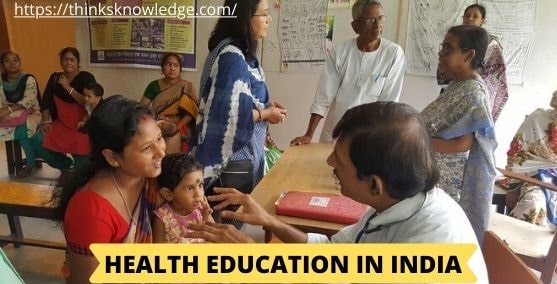We all know that health education in India has become very important now a day. It not only focuses on physical health but also mental illnesses, sexual and many other issues. It also refers to a career where people are taught about health care. Professionals teach people how to maintain and restore their health.
Health has a very wide meaning. Where it refers to a physiological, functional or metabolic state or it refers to a human body, brain, and attitude. In other words, health is the state of freedom from disease and sorrow pain. The World Health Organization has defined it broadly in 1946, according to which health does not mean sickness or weakness, but health is the full state of physical mental and social welfare.

Table of Content
Importance of health education
Health education is the knowledge imparted by professionals to the general public. They are qualified and certified to talk about these issues. Apart from this, they also undergo training related to health and hygiene to educate people.
Health education is very important to enhance the overall health status of various communities and people. It also helps in improving the health of the entire nation. We can also say that the economy of a country is directly proportional to health education.
In other words, this means that the higher the life expectancy, the better the standard of living. Similarly, health education is very important because it improves the health conditions of the people. It protects their health by teaching them how to stay healthy and prevent diseases. Apart from this, it also makes them sufficiently responsible as a whole community.
Healthcare in India
There is no national health insurance system for citizens of India. This is why the private sector is the main health provider in our country. Government hospitals are in country provided free of cost medicines. India maximum population lives in rural areas away from these hospitals due to lack of hygiene. These services are provided free of cost, there are long lines here.
The government should work to maintain these facilities and set up more hospitals in remote areas for cater the needs of every citizen. The common man in India requires huge amounts of money for health care. Most of the savings he spends are spent taking care of his family’s health. People who buy healthcare insurance also need money during various treatments because these policies have many drawbacks.
Strengths of Health Education in India
One of the main strengths of health education in India is the presence of multi level infrastructure in both the government and private sectors. The Central Health Education Bureau works with the State Health Education Bureau at the block level.
The health education in India lies in successful information delivery across states, despite lingual variations. India has 15 official languages and several local sublanguages. Even then health education programs are capable of conveying success successfully.
In India there is a skillfully trained workforce including nurses and doctors. Most health educators in India are either undergraduates or postgraduates.
Weaknesses of health education in India
- Weaknesses of health education in India include lack of research and development.
- Inability to reach all remote villages there is no road to development for health educators.
- The method of training and education in public health is traditional and there is a dire need for professionals to integrate modern technologies with better performance.
- Another weakness of health education in India is the lack of a path to better development for officials.
- Not properly organized this occupation is attractive to youth. That is the reason low interest for youth.
- Most campaigns on health education rely on print media for publicity in the government or private sector.
- About 40% of Indians are unable to read or write, which does not allow the purpose to be met because promotion fails to reach the grassroots illiterate.
AWARENESS OF HEALTH AND NUTRITION
Nutrition campaign
National Nutrition Mission is India program launched in March 2018. There aims are to improve the nutritional status of children up to 6 years of age. Included with adolescents, pregnant women and lactating mothers under nutrition etc. The nutrition campaign is a mass movement and participation. To give impetus to the nutrition campaign, on 24 July 2018, the National Council of India’s Nutrition Challenges decided to consider September as National Nutrition Month. During this month, nutrition related awareness activities are carried out at the grassroots level by all the States / UTs.
Some Other Major Schemes
- Integrated Child Development Scheme
- Mid-Day Meal Scheme
- Targeted Public Distribution System
- Total Sanitation Campaign
- National Rural Drinking Program
- Nutrition Education and Training through Community Food and Nutrition Extension Units.
Prime Minister’s Health Protection
The scheme was launched in 2003 to provide quality medical education along with improving regional imbalances for the availability of affordable and reliable tertiary health services.
National Health Mission
NHM consists of two sub-missions, the National Rural Health Mission and the National Urban Health Mission. Key components of the program include health system strengthening, reproductive the maternal newborn and adolescent health (RMNCH + A), and communicable and non-communicable diseases. NHM is universally responsible and responsible for delivering equal, affordable and quality healthcare services and meeting the needs of the people.
The National Healthcare Innovation Portal is a major effort to pool in and better showcase. In this innovative design, practices, technology solutions in Indian public and private healthcare sector.
AYUSHMAN INDIA
Health and wellness centers provide comprehensive services such as preventive, incentive, treatment, rehabilitation along with moving from a selective approach to appropriate health care. It has two major components which is given following:
-
Under the first component
provide 1.5 lakh Health and Wellness Centers (HWCs) are being built to provide comprehensive primary health care, which is universal and free for users. It focuses on the welfare of the community and providing comprehensive services (care for non-communicable diseases, palliative / rehabilitation care, oral, eye and ENT care, mental health and first-level care during emergencies / trauma, free Essential medicines and diagnostic services).
-
The second component
is the Pradhan Mantri Jan Arogya Yojana (PM-JAY) which provides health insurance cover up to Rs 5 lakh per year to more than 10 crore poor and vulnerable families for secondary / tertiary health care.
‘Mera Hospital’ is an initiative by the Ministry of Health, Government of India. Patient response too many user friendly channels such as short messaging services (SMS). The aim is to help the government take appropriate decisions to enhance the quality of healthcare delivery in public facilities. This is the main focus area for improving the patient experience.
Prime Minister Shri Narendra Modi launched the intensive Mission Indradhanush on 8 October 2017 to further vaccination program. The objective of this program is to reach every child up to 2 years of age and all pregnant women who were abandoned under the regular vaccination program / universal immunization program.
Despite various government programs about improving and promoting the quality of health education in India, many still do not have access to basic health services and are out of reach of public health educators, because of lack of necessary infrastructure at the ground level is.
Many programs aimed at raising public awareness about AIDS, cancer, malaria etc., failed to build the necessary infrastructure at the ground level. Adequate infrastructure and well-trained and well-equipped workforce is needed to make health education a success in India.





